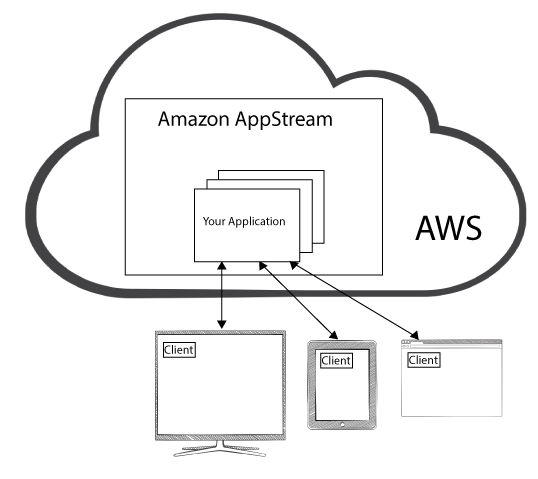
Amazon Web Services (AWS) has become the giant of instant infrastructure, and its cloud services have become essential to a whole generation of Internet-based businesses, ranging from small startups to media upstarts. At the company's Re:Invent conference in Las Vegas today, AWS took steps to make itself even more essential to developers and even to take on virtualization providers like VMware and Citrix.
In his keynote, Senior Vice President of Amazon Web Services Andy Jassy announced three new services. Two of the services—Amazon AppStream and Amazon WorkSpaces—use cloud computing power to deliver applications to end users. The third, Amazon CloudTrails, will help audit and lock down access to AWS-based applications.
AppStream
Jassy first highlighted the success of "all in" companies such as Netflix, which runs its entire infrastructure in the Amazon cloud. Netflix could easily have been the inspiration for Amazon's new AppStream, a media and interactive content streaming service.
While Amazon has had a video and audio streaming solution for some years—Amazon Cloudfront’s support for Adobe Flash Media Server—AppStream is oriented toward streaming content for applications that require high-definition video and features like interactivity and user authentication. AppStream uses the H.264/AVC video format for up to 720p/30fps encoded streaming video, as well as the open source Opus audio format for 16-bit/48kHz audio.
Any client will require at least a 3Mbps connection to receive video and audio. But AppStream can also be used with "hybrid" applications, where basic functionality is available when a client is disconnected from the cloud but gains additional features when there is a network connection available. Amazon suggests 3D games or "interactive HD applications” as the initial target audience for Appstream.
The server-side of AppStream applications runs in an Amazon EC2 64-bit Windows Server 2008 R2 instance (though the applications can be 32-bit or 64-bit), and it must be modified to output video and audio through AppStream's SDK for Windows rather than to standard Windows output. This is a lot more effort than you need for Adobe Flash Media Server, but if you’re running a closed service, such as a multi-player gaming site or an interactive video solution, Amazon provides all of the infrastructure to get you up and running.
Amazon is offering the service for free for the first 20 hours of streaming per month, with additional demand metered at 83 cents per hour. It's not yet clear if that's less expensive than other streaming solutions on the market, but AppStream definitely simplifies the process of building and managing a video streaming infrastructure—both because it has an end-to-end SDK for developers and because developers can leverage Amazon's auto-scaling capabilities to meet scalability demands. And part of the value proposition for the extra development effort is that developers can not only stream audio and video but also add interactivity and what Amazon calls an "entitlement" service—which is essentially user authentication.
Amazon WorkSpaces
It was only a matter of time before Amazon entered the virtual desktop market.
With Amazon WorkSpaces, Amazon now has a cloud-based VDI (virtual device infrastructure) that, if nothing else, should lower some pricing in the industry.
Like all Amazon Web Service products, it’s pay-as-you-go. WorkSpaces costs from $35 to $75 per month per user. At the bottom end, a WorkSpaces instance comes with the equivalent of 1 CPU, 3.75 gigabytes of RAM, and 50 gigabytes persistent storage; more CPUs, RAM, and storage cost incrementally more, and licensed software like MS Office Professional can be pre-installed for an additional charge.
AWS' virtual desktops are Windows 7-like instances, accessible using the PCoIP protocol. They can be accessed from a variety of devices: Mac OS and Windows desktops, as well as iPad, Kindle Fire, and Android tablets. In the spirit of the hybrid IT approach, Amazon lets you tie your WorkSpace deployments to your existing Active Directory service running on your local premises.
You can integrate Active Directory using an Amazon Virtual Private Cloud or AWS Direct Connect so that your Amazon WorkSpace end users can continue to use their existing credentials. This also means that you can use your existing AD Management tools to manage security policies for your Amazon WorkSpaces users and choose which users can use the service.
WorkSpaces is only available to a limited number of users at the moment. You can sign up through AWS' WorkSpaces website for a limited preview.
Amazon CloudTrail
Just when you thought you had unsubscribed from every tracking service, along comes Amazon CloudTrail, Amazon’s new service that will log all of the Amazon Web Services API traffic associated with a given account—and they mean all the traffic: command line calls, SDK calls, and even calls initiated from the Amazon Management Console. For big API users, CloudTrails should provide some quality security data and usage metrics.
For each API call, the user’s Amazon account ID, access key ID, and username is logged, as well as details of the actual call parameters, including the source IP address, user agent string, and date/time of the call. For storage, the logs are automatically stored in Amazon S3 or Amazon Glacier. It’s actually surprising that this service doesn’t already exist, since one can barely think of a major authenticated service on the Internet that is not extensively logged.
With AppStream and WorkSpaces, Amazon Web Services continues to push into existing markets, potentially lowering price points and providing interesting competition. CloudTrails will most likely show up soon in third-party monitoring tools.
Jason Levitt is a former InformationWeek Labs editor, a former Yahoo technology evangelist, and a current Austin-based software consultant.
reader comments
17